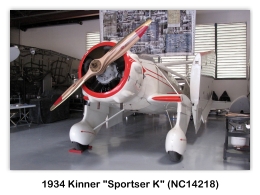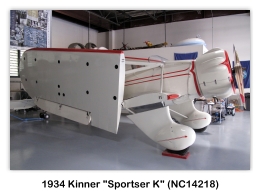

























Kinner Sportster K
American single-engine Two-seat Open Cockpit Light Monoplane
Archive Photos 1
1934 Kinner Sportster K (NC14218, s/n 136) at the 2009 Cable Air Show, Cable Airport, Upland, CA



Overview 2
- Role: Light monoplane
- Manufacturer: Kinner Airplane & Motor Corporation
- First flight: 1932
The Kinner Sportster was a 1930s American light monoplane built by Kinner Airplane & Motor Corporation.
Design and Development 2
Prior to 1932, the Kinner Airplane & Motor Corporation was known only as an aero-engine manufacturer, and the five Kinner radial air-cooled engines of 100-hp, 125-hp, 160-hp, 210-hp and 300-hp were used very largely in the United States.
In 1932, the Kinner Airplane & Motor Corporation announced its entry into the aeroplane manufacturing field with a number of light commercial monoplanes, all built around Kinner engines. The range of aircraft included:
- Two-seat open-cockpit monoplane (100-hp or 125-hp Kinner engine)
- Two-seat convertible monoplane (160-hp Kinner engine)
- Two cabin monoplanes, one seating two and the other four, the first with the 160-hp and the second with the 370-hp Kinner engine, and
- Twin-engined, five-seven-passenger monoplane with two 370-hp Kinner engines.
Kinner became bankrupt in 1937 and rights to the Sportster were acquired by the Timm Aircraft Company.
Kinner Sportster Specifications 2
Type
- Two-seat open cockpit light monoplane.
Wings
- Low-wing folding monoplane.
- Clark "Y" wing section.
- Wings attached to short stubs built integral with the fuselage and braced to the top fuselage longerons by inverted Vee struts.
- Wing structure consists of spruce spars and ribs, with fabric covering.
- Wings fold back along the fuselage and a positive lock holds them in flying position.
- Frise type ailerons.
Fuselage
- Rectangular structure of welded steel-tube, with fabric covering.
Tail Unit
- Normal monoplane type.
- Welded steel-tube framework, covered with fabric.
- Adjustable tail-plane.
Undercarriage
- Divided type.
- Kinner oleo telescopic legs.
- Full airwheels for landing gear and tail-wheel.
- Independent wheel-brakes, which may be operated simultaneously or independently by either foot or hand controls.
- Swivelling tail-wheel.
Power Plant
- One 100 or 125-hp Kinner K-5 or B-5 five-cylinder radial air-cooled engine, on hinged mounting which, by the removal of two bolts, may be swung to one side to give access to accessories.
- Main fuel tank, of 21 U.S. gallons capacity, in fuselage.
- Reserve fuel tank, of 2-1/2 U.S. gallons capacity, in fuselage, with control on instrument panel.
- Oil tank, of 3 U.S. gallons capacity, in fuselage.
Accommodation
- Open cockpit, seating two side-by-side, over wing.
- Adjustable seats.
- Complete dual controls.
- Large luggage space in each wing-stub.
- Special provision for carrying golf clubs, guns, fishing rods, etc.
- Optional cockpit enclosure.
Dimensions
- Span: 39 ft (11.9 m)
- Length: 24 ft 2 in (7.36 m)
- Height: 7 ft (3.23 m)
- Wing area: 227 ft² (21 m²)
Weights and Loadings (100-hp Kinner engine)
- Weight empty: 1,218 lbs (553 kg)
- Weight loaded: 1,875 lbs (851 kg)
- Wing loading: 9.28 lbs/ft² (45.28 kg/m²)
- Power loading: 18.75 lbs/hp (8.5 kg/hp)
Weights and Loadings (125-hp Kinner engine)
- Weight empty: 1,232 lbs (559 kg)
- Weight loaded: 1,875 lbs (851 kg)
- Wing loading: 8.9 lbs/ft² (43.4 kg/m² )
- Power loading: 14.4 lbs/hp (6.5 kg/hp)
Performance (100-hp Kinner engine)
- Maximum speed: 104 mph (166.4 km/h.)
- Cruising speed: 90 mph (144 km/h.)
- Landing speed: 40 mph (64 km/h)
- Initial rate of climb: 800 ft/min (244 m/min)
- Service ceiling: 14, 000 ft (4,270 m)
- Cruising range: 340 Miles (544 km)
Performance (125-hp Kinner engine)
- Maximum speed: 112 mph (174 km/h.)
- Cruising speed: 100 mph (160 km/h.)
- Landing speed: 35 mph (56 km/h)
- Initial rate of climb: 900 ft/min (274.5 m/min)
- Service ceiling: 15,000 ft (4,575 m)
- Cruising range: 400 miles (640 km)
References
- Photos. 2009 Cable Air Show, Cable Airport, Upland, CA (1/11/2009) by John Shupek
- Bridgman, Leonard (ed.), Jane’s All The World’s Aircraft 1936. London, Sampson Low, Marston & Company, Ltd., 1936. pp 288c


































































